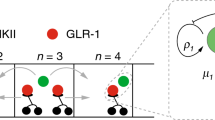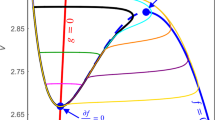Abstract
This article focuses on the set of 32 legal elementary cellular automata (ECA). We perform an exhaustive study of the systems’ response under: (i) α-asynchronous dynamics, from full asynchronism to perfect synchrony, (ii) κ-scaling, which extends α-asynchrony to compensate for less cell activity, and (iii) ϕ-noise scheme, a perturbation that affects the local transition function and causes a cell to probabilistically miscalculate the new state when it is updated. We propose a new classification in three classes under asynchronous conditions: α-invariant, α-robust, and α-dependent. We classify the 32 legal ECA according to the degree of behavioural modification, and we show that our classifying scheme provides results coherent with the density-based classification. We also show that κ-scaling provides results comparable to synchronous systems, both quantitatively and qualitatively. Subsequently, we analyse the effects of including different levels of noise in synchronous systems. We identify different responses to noise, including systems that are robust to asynchrony and susceptible to noise. To conclude, we investigate the behavioural changes caused by simultaneous asynchrony and noise in models tolerant to both perturbations. We describe a number of effects caused by the interplay of noise and asynchrony, thus further reinforcing that both aspects are pertinent for future studies.









Similar content being viewed by others
Notes
See supplementary material for references to the complete set of results presented in the article.
References
Bandini S, Bonomi A, Vizzari G (2012) An analysis of different types and effects of asynchronicity in cellular automata update schemes. Nat Comput 11(2):277–287
Berry H (2003) Nonequilibrium phase transition in a self-activated biological network. Phys Rev E 67(3):031,907
Bersini H, Detours V (1994) Asynchrony induces stability in cellular automata based models. In: 4th international conference on simulation & synthesis of living systems (ALIFE IV). MIT Press, Cambridge, pp 382–387
Blok HJ, Bergersen B (1999) Synchronous versus asynchronous updating in the game of life. Phys Rev E 59(4):3876
Bouré O, Fatès N, Chevrier V (2012) Probing robustness of cellular automata through variations of asynchronous updating. Nat Comput. doi: 10.1007/s11047-012-9340-y
Braga G, Cattaneo G, Flocchini P, Vogliotti C (1995) Pattern growth in elementary cellular automata. Theor Comput Sci 145(1–2):1–26
Cattaneo G, Finelli M, Margara G (2000) Investigating topological chaos by elementary cellular automata dynamics. Theor Comput Sci 244(1–2):219–241
Chevrier V, Fatès N (2008) Multi-agent systems as discrete dynamical systems: influences and reactions as a modelling principle. Tech. rep., INRIA-LORIA. http://hal.inria.fr/inria-00345954
Cornforth D, Green D, Newth D (2005) Ordered asynchronous processes in multi-agent systems. Physica D 204(1):70–82
Correia L (2006) Self-organisation: a case for embodiment. In: Gershenson C, Lenaerts T (eds) Evolution of complexity workshop, held as part of the 10th international conference on simulation and synthesis of living systems (ALIFE X), pp 111–116
Correia L (2006) Self-organised systems: fundamental properties. Revista de Ciências da Computação 1(1):9–26
Correia L, Wehrle T (2006) Cellular automata under the influence of noise. eprint arXiv:nlin/0604071 Xiv:nlin/0604071
Dennunzio A, Formenti E, Manzoni L (2012) Computing issues of asynchronous CA. Fundam Inf 120(2):165–180
Dennunzio A, Formenti E, Provillard J (2012) Non-uniform cellular automata: classes, dynamics, and decidability. Inf Comput 215:32–46
Dennunzio A, Formenti E, Manzoni L, Mauri G (2013) m-asynchronous cellular automata: from fairness to quasi-fairness. Nat Comput. http://hdl.handle.net/10281/43525
Fatès N (2003) Experimental study of elementary cellular automata dynamics using the density parameter. Discret Math Theor Comput Sci AB:155–166
Fatès N (2006) Directed percolation phenomena in asynchronous elementary cellular automata. In: Yacoubi SE, Chopard B, Bandini S (eds) 7th international conference on cellular automata for research and industry (ACRI’06). Springer, Heidelberg, pp 667–675
Fatès N (2009) Asynchrony induces second order phase transitions in elementary cellular automata. J Cell Autom 4(1):21–38
Fatès N, Morvan M (2005) An experimental study of robustness to asynchronism for elementary cellular automata. Complex Syst 16(1):1–27
Fatès N, Regnault D, Schabanel N, Thierry E (2006) Asynchronous behavior of double-quiescent elementary cellular automata. In: Correa JR, Hevia A, Kiwi M (eds) LATIN 2006: theoretical informatics, Lecture notes in computer science, vol 3887. Springer, Heidelberg, pp 455–466
Fuks H, Skelton A (2011) Orbits of the Bernoulli measure in single-transition asynchronous cellular automata. In: 17th international workshop on cellular automata and discrete complex systems (Automata 2011). Discrete Mathematics and Theoretical Computer Science, pp 95–112. http://www.dmtcs.org/dmtcs-ojs/index.php/proceedings/article/view/dmAP0107
Gács P (2001) Reliable cellular automata with self-organization. J Stat Phys 103(1–2):45–267
Gács P, Reif J (1988) A simple three-dimensional real-time reliable cellular array. J Comput Syst Sci 36(2):125–147
Glass L (2001) Synchronization and rhythmic processes in physiology. Nature 410(6825):277–284
Grilo C, Correia L (2011) Effects of asynchronism on evolutionary games. J Theor Biol 269(1):109–122
Gunji Y (1990) Pigment color patterns of molluscs as an autonomous process generated by asynchronous automata. Biosystems 23(4):317–334
Hamming R (1950) Error detecting and error correcting codes. Bell Syst Tech J 29(2):147–160
Ingerson T, Buvel R (1984) Structure in asynchronous cellular automata. Physica D 10(1–2):59–68
Inghe O (1989) Genet and ramet survivorship under different mortality regimes a cellular automata model. J Theor Biol 138(2):257–270
Kanada Y (1997) The effects of randomness in asynchronous 1d cellular automata. Techical report, Tsukuba Research Center
Mallet D, De Pillis L (2006) A cellular automata model of tumor–immune system interactions. J Theor Biol 239(3):334–350
Manzoni L (2012) Asynchronous cellular automata and dynamical properties. Nat Comput 11(2):269–276
Ódor G, Szolnoki A (1996) Directed-percolation conjecture for cellular automata. Phys Rev E 53(3):2231–2238
Ódor G, Boccara N, Szabó G (1993) Phase-transition study of a one-dimensional probabilistic site-exchange cellular automaton. Phys Rev E 48(4):3168–3171
Regnault D (2006) Abrupt behaviour changes in cellular automata under asynchronous dynamics. In: 2nd European conference on complex systems (ECCS 2006), pp 116–121. http://www.cabdyn.ox.ac.uk/complexity_PDFs/ECCS06/Conference_Proceedings/PDF/p116.pdf
Regnault D (2013) Proof of a phase transition in probabilistic cellular automata. In: Bal MP, Carton O (eds) Developments in language theory, Lecture notes in computer science, vol 7907. Springer, Heidelberg, pp 433–444
Roca CP, Cuesta JA, Sánchez A (2009) Effect of spatial structure on the evolution of cooperation. Phys Rev E 80(4):046,106
Roca CP, Cuesta JA, Sánchez A (2009) Evolutionary game theory: temporal and spatial effects beyond replicator dynamics. Phys Life Rev 6(4):208–249
Ruxton GD, Saravia LA (1998) The need for biological realism in the updating of cellular automata models. Ecol Model 107(2–3):105–112
Schönfisch B, de Roos A (1999) Synchronous and asynchronous updating in cellular automata. Biosystems 51(3):123–143
Silva F, Correia L (2011) Noise and intermediate asynchronism in cellular automata with sampling compensation. In: 15th Portuguese conference on artificial intelligence (EPIA’11), pp 209–222
Silva F, Correia L (2012) A study of stochastic noise and asynchronism in elementary cellular automata. In: Sirakoulis GC, Bandini S (eds) 10th international conference on cellular automata for research and industry (ACRI 2012), Lecture notes in computer science, vol 7495. Springer, Heidelberg, pp 679–688
Smith H (1935) Synchronous flashing of fireflies. Science 82(2120):151–151
Strogatz SH, Stewart I (1993) Coupled oscillators and biological synchronization. Sci Am 269(6):102–109
Toom A (1980) Multicomponent random systems, Advances in probability. In: Stable and attractive trajectories in multicomponent systems, vol 6. Marcel Dekker, New York
Weifeng F, Lizhong Y, Weicheng F (2003) Simulation of bi-direction pedestrian movement using a cellular automata model. Physica A 321(3):633–640
Wolfram S (1983) Statistical mechanics of cellular automata. Rev Mod Phys 55(3):601–644
Wolfram S (1985) Twenty problems in the theory of cellular automata. Phys Scr T9:170–183
Wolfram S (2002) A new kind of science. Wolfram Media, Champaign
Acknowledgements
We would like to thank Carlos Grilo for helpful discussions during the preparation of the manuscript, Mel Todd for the assistance in spelling, and the anonymous reviewers for their valuable comments and references. This work was partly supported by the Fundação para a Ciência e a Tecnologia (FCT) under the grants SFRH/BD/89573/2012 and PEst-OE/EEI/UI0434/2011.
Author information
Authors and Affiliations
Corresponding author
Electronic supplementary material
Below is the link to the electronic supplementary material.
Rights and permissions
About this article
Cite this article
Silva, F., Correia, L. An experimental study of noise and asynchrony in elementary cellular automata with sampling compensation. Nat Comput 12, 573–588 (2013). https://doi.org/10.1007/s11047-013-9387-4
Published:
Issue Date:
DOI: https://doi.org/10.1007/s11047-013-9387-4




